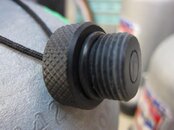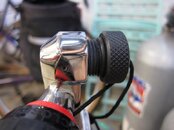It could be. If you aren't sure, take a cylinder handling class. To be sure, this was a real snake in the grass. No way to anticipate the results at all.
I'd like to recommend a separate Thread on the safe storage and transport of O2 bottles.
Welcome to ScubaBoard, the world's largest scuba diving community. Registration is not required to read the forums, but we encourage you to join. Joining has its benefits and enables you to participate in the discussions.
Benefits of registering include
It could be. If you aren't sure, take a cylinder handling class. To be sure, this was a real snake in the grass. No way to anticipate the results at all.
Good idea. Go for it.I'd like to recommend a separate Thread on the safe storage and transport of O2 bottles.
 You might link it here.
You might link it here.About using the plugs on DIN valves: the XSScuba convertible valves have a small pressure relief hole in the side. With the plug tight and the valve open the gas escapes through this vent and you hear a loud hiss. It also limits the rate of loss of gas. So for this particular valve using the DIN plug would help to pick up a leak and to limit the rate of leak.
All three of my tanks have the valves with the side vent.

Yes!! Advanced Nitrox! That teaches you HOW to use it safely. But that's not saying that the average diver could not buy or use it if he felt so compelled. I personally don't know that it is very rigidly enforced.
This incident has got me thinking. I have 100% O2 bottles for SCUBA Rescue in my garage. Is this an unsafe practice?
Adam, I presume you're speaking about this pressure relief hole in the valve. The behavior you describe is not normal.

The XS Scuba (aka Thermo) DIN/Yoke valve
If gas leaks from this hole with the DIN plug tight, you must have either an o-ring missing, or a displaced o-ring.
Leaking from this hole with a plug inserted is not by design: the DIN plug mimics the connection made by a DIN regulator, so if it leaks with a plug, it will also leak when using a regulator - hardly a good design goal.
It takes quite a bit of displacement to get to the point where this hole allows gas to escape. When I've pressurized a valve with a DIN plug inserted, it usually takes me ~3 turns of the wrench, backing the plug out, until the gas vents from the pressure relief.
I for one want a DIN plug to be solid. When it's in place, I know I won't loose $150 worth of fill just because someone stubbed a toe on the valve. The relative safety of putting such a DIN plug on a 100% O2 cylinder is being debated over on this thread.
In terms of prevention, one possibility that's being discussed for this accident is an oxygen-rich environment caused by a slow leak. Certainly an intentionally vented DIN plug wouldn't have prevented this. Even a solid DIN plug may not have; there are many other slow leak sources, such as a loose bonnet, that are yet to be eliminated.
All the best, James
I have been following this thread and do not understand how the O2 rich air in an auto interior caused an explosion. I can see a very hot, uncontrollable fire, but what would fuel a violent explosion?
Can someone enlighten me?
I have been following this thread and do not understand how the O2 rich air in an auto interior caused an explosion. I can see a very hot, uncontrollable fire, but what would fuel a violent explosion?
Can someone enlighten me?
Hi James, I looked at my tanks again, and the key I think to the difference is the design of the plug. My plugs are plastic and have an O ring NOT in the same place as a DIN reg, rather just inside the knurled outside part. Later in the day I'll see if I can take a photo. The inside part of the plug allows the air to leak out through the vent even when the plastic plug is tight.
Your plug must be designed like the male part of the DIN reg and totally seals the tank like a reg.
Adam



